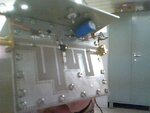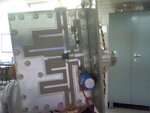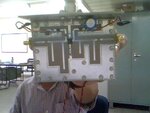aks.rfms
Junior Member level 2
I have design an power amplifier , in simulation its showing proper result but after fabrication , i mount it on heat sink.
The rated specification are
--LDMOS device free-scale.
-- drain voltage -- 28 Volt
-- Gate voltage -- 3.8 volt
-- rated Input -- 21 dBm
-- rated output -- 45 dBm
-- gain -- 23 dB
-- optimum current -- 330mA.
but after mounting...
i give 28 Volt drain side , but as i raise the voltage to gate side about 2.8 Volt it went into oscillation,
i provide proper vias for grounding even after it show the 33 dBm out put ,without any rf input (in biasing condition only), and shows current of 300 mA.
it does not show any effete even i give rf to optimum input level.
kindly guide me to get out of oscillation and get proper out put..
thanking you
The rated specification are
--LDMOS device free-scale.
-- drain voltage -- 28 Volt
-- Gate voltage -- 3.8 volt
-- rated Input -- 21 dBm
-- rated output -- 45 dBm
-- gain -- 23 dB
-- optimum current -- 330mA.
but after mounting...
i give 28 Volt drain side , but as i raise the voltage to gate side about 2.8 Volt it went into oscillation,
i provide proper vias for grounding even after it show the 33 dBm out put ,without any rf input (in biasing condition only), and shows current of 300 mA.
it does not show any effete even i give rf to optimum input level.
kindly guide me to get out of oscillation and get proper out put..
thanking you


